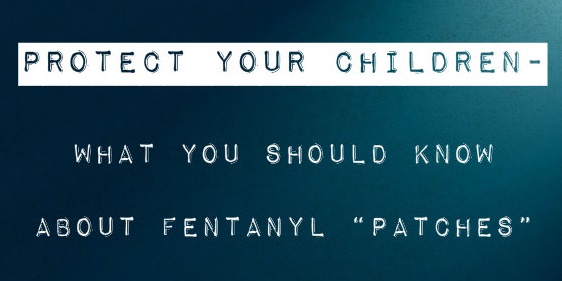03 Sep 2013
Fentanyl “Patches” – Deadly For Children
A 12-year-old girl from Clinton, Missouri was found dead in June 2013 after a suspected overdose of the Fentanyl patch. Destiny Spilter died after she stuck a used fentanyl patch on her thigh. The patch had been previously worn by her grandmother who, once done with it, threw it in the trash.
Fentanyl is an extremely strong opioid used to manage pain. It is 100 times more potent than morphine and 40 times stronger than heroin. Overdoses, some even fatal, are common.
Many patients are prescribed Fentanyl when other types of narcotic pain medications no longer offer relief. In most cases, this is because the body has developed tolerance to the pain killer, and it needs more and more of the substance to offer the same type of relief. Since many medications are lethal at such high doses, doctors must look to a different medication altogether instead of just increasing the dose of the current prescription. Fentanyl is a favored tool in the pain-management arsenal.
Use with Extreme Caution
Despite its benefits, however, Fentanyl must be used with extreme caution as even patients who have topped out of their traditional pain medications have found it to be too strong to tolerate. The patch, even at its lowest dose, has the potential to reduce respiration to the point of death.
The Fentanyl patch was created to offer continuous relief to patients in chronic pain, but over a period of several days. If a person were to ingest that amount of Fentanyl all at once, it would likely be fatal. Given its high potency, there are a number of safety advisories and side effect warnings regarding use of the drug. One of the FDA warnings recommends flushing the patch after use so that unintended recipients do not ingest the remaining residue — either accidentally or on purpose. Even though the Agency recognized that there may be some environmental concerns about flushing, it felt that the risk associated with accidental exposure far outweighed any potential risk to the environment or water sources.
Tragedy – Too Often
Destiny’s grandmother, who was using the patch to manage her chronic back pain, did not follow these fairly simple instructions. Not surprisingly, the curious young girl found the patch and put it on, perhaps mimicking the behavior she previously observed in her grandmother. Even after the patch is used for three days, studies show that it could still contain more than 50 percent of the original Fentanyl dose. Her body was unable to handle even the amount of Fentanyl that remained in the patch and she died.
Unfortunately, accidental overdose is not uncommon for the Fentanyl patch — especially in children. Children may be initially attracted to the patch, thinking that it is a sticker. And because the patch is meant to stay on the skin for up to 3 days, there is typically plenty of glue remaining to keep it securely on the child’s skin. If they place it in an area that is hidden by clothing, caretakers may not notice it until the damage has been done.
On May 14, 1988, a drunk driver going the wrong way on an interstate highway just outside Carrollton, Kentucky, collided head on with a school bus full of children. In total, 24 children and three adults were killed in this horrific accident, making it the most deadly alcohol-related automobile crash in U.S. history. In commemoration of the 25th anniversary of this tragic event, on May 14of this year the National Transportation Safety Board issued a new report urging all 50 states to lower the legal limit of intoxication for anyone operating a motor vehicle from .08 blood-alcohol content to .05, a standard that is already in place in about 100 other countries around the world.
Referring to the approximately 10,000 deaths that occur in the United States each year in alcohol-related automobile accidents as “a national epidemic,” NTSB Chairman Deborah Hersman expressed her organization’s concern that the ongoing campaign to reduce drunken driving fatalities had reached a point of diminishing returns. The NTSB’s recommendation that blood-alcohol level restrictions for drivers be tightened is in accordance with the latest scientific findings, which show that a person with a BAC of .05 will experience “reduced coordination, reduced ability to track moving objects, difficulty steering, and reduced response to emergency driving situations” (quoted from a chart published by the National Highway Traffic Safety Administration). The NTSB estimates that if this new standard were universally adopted, it could lead to a 10 percent annual decrease in the number of people killed by drunken drivers, and it is urging the National Highway Traffic Safety Administration to offer financial incentives to any state that will agree to make the switch from .08 to .05.
Sensible Caution or Mindless Prohibition?
 As recently as the early 1980s, people who had been drinking were legally allowed to get behind the wheel of an automobile in many states as long as their blood-alcohol content did not rise above .15. But in response to rising public and political awareness of the true costs of drunk driving, legal standards began to evolve and by 2004 all 50 states had adopted the far more stringent .08 standard that still reigns supreme today. Since the heyday of .15, annual casualties from alcohol-related automobile accidents have dropped from 20,000 per year to just under 10,000, but drunken driving still accounts for about one-third of all highway deaths in the United States, more than any other single factor. Over the years, legal penalties for driving under the influence have become more severe in concurrence with the tightening of the BAC, and bars, clubs, and restaurants by all accounts have become more responsible about serving alcohol to customers who may be intoxicated. Nevertheless, drunk driving has remained stubbornly and discouragingly prevalent, and its consequences have continued to leave a long trail of broken bodies lying in the wrecked and smoldering ruins of crashed automobiles each and every year.
As recently as the early 1980s, people who had been drinking were legally allowed to get behind the wheel of an automobile in many states as long as their blood-alcohol content did not rise above .15. But in response to rising public and political awareness of the true costs of drunk driving, legal standards began to evolve and by 2004 all 50 states had adopted the far more stringent .08 standard that still reigns supreme today. Since the heyday of .15, annual casualties from alcohol-related automobile accidents have dropped from 20,000 per year to just under 10,000, but drunken driving still accounts for about one-third of all highway deaths in the United States, more than any other single factor. Over the years, legal penalties for driving under the influence have become more severe in concurrence with the tightening of the BAC, and bars, clubs, and restaurants by all accounts have become more responsible about serving alcohol to customers who may be intoxicated. Nevertheless, drunk driving has remained stubbornly and discouragingly prevalent, and its consequences have continued to leave a long trail of broken bodies lying in the wrecked and smoldering ruins of crashed automobiles each and every year.
Not surprisingly, the alcohol and hospitality industries have responded to the .05 recommendation negatively, calling it unnecessary, excessive, and bad for the economy. Others have pointed out that current laws already allow police officers to arrest drivers who appear intoxicated regardless of what their blood-alcohol levels might be, and they claim that the only people who will be taken into custody under these new restrictions will be those with BACs of .05 who show no actual signs of being impaired. Even some people involved in the fight against drunk driving have expressed skepticism about the idea of reducing the allowable BAC, believing that it will create a backlash that may ultimately hurt the anti-drunk driving cause by linking it to draconian laws that will not be popular with most people. Skeptics also argue that this new law would be all but unenforceable, since police would be expected to somehow know intuitively that drivers had reached the legal limit for intoxication and needed to be pulled over, even though in most cases their driving performances would appear to fall entirely within the range of normal.
The Power of Prevention
Some of these criticisms could very well prove to be legitimate, if the new standards are eventually adopted. However, government regulatory and safety agencies can only base their policies and recommendation for change on what the latest research shows, and in this case the science is clear: at .05 BAC the reflexes and perceptions of human beings are altered dramatically, and regardless of whether a person shows obvious signs of drunkenness, their ability to drive will be impaired if they have been drinking enough to reach this level of intoxification, thereby putting themselves, their passengers, and everyone else on the roadways at risk. While there may indeed be some backlash in the short-term against a move to .05, if there is any chance at all that such a move will discourage drinking and driving then this new proposal by the NTSB clearly has merit.
During the time when BAC driving requirements were being progressively tightened, from approximately 1980 through 2004, drunken driving-related casualty levels declined significantly and no one can reasonably argue that this is just a coincidence. Based on past precedent it appears very likely that these new recommendations will in fact be adopted at some point, and if and when that happens we can only hope that from then on fewer families will be forced to confront the premature loss of cherished loved ones as a result of a tragic—and entirely preventable—alcohol-fueled automobile crash.
Curbing drug use isn’t something that can be solely dealt with at a national level. Effective policies must be put in place on a global scale. In 2010, approximately 5 percent of people all over the world, or 230 million individuals, admitted to engaging in illegal drug use at least once.
 The United Nations Office on Drugs and Crime (UNODC) has been working since 1961 to control drug use in order to preserve public health and welfare. Each year, illegal drugs claim the lives of around 200,000 people. So many of these individuals might not have had to die had they received the help they needed.
The United Nations Office on Drugs and Crime (UNODC) has been working since 1961 to control drug use in order to preserve public health and welfare. Each year, illegal drugs claim the lives of around 200,000 people. So many of these individuals might not have had to die had they received the help they needed.
Since its inception, the organization has made an effort to combat this issue not only with law enforcement, but also with policies that would address the deeper core issues of health and addiction.
According to Reuters, the UNODC global drug conventions that took place in 1961, 1971 and 1988 have helped standardize the world’s drug regulation policies, reducing the proliferation of illegal drugs. In fact, even as the world’s population has continued to multiply over the last hundred years, global production of opium, for instance, has decreased by 80 percent.
Many individuals addicted to drugs are sick and do not belong in a prison with hardcore criminals. While there are those who would say that legalizing drugs is the answer to combat the international drug problem, proponents of the UNODC efforts say that current measures are working.
But for these measures to continue being effective, countries around the world must offer education, rehabilitation, and social reintegration programs to drug offenders rather than prison sentences. Receiving these individuals as patients instead of criminals presents the greatest opportunity for change so that everyone has the chance to lead a healthy life free from drugs and crime.
Drugs available in your backyard? Teens say drugs easy to get their hands on in New Mexico.
The college years are filled with opportunities to compete. From academic contests to dorm room antics, there is a drive on campus to define hierarchies and social order. Even in college partying, where the scene may seem to be much more chaos and order, there are social ordering activities taking place. Drinking games are often used to show how a person handles alcohol or can retain their cognitive abilities while under the influence.
Previous studies have shown that engaging in drinking games can predict whether a college student will drink heavily. However, little is known about whether the type of drinking game will affect how heavily a student will drink. Recently a team of researchers examined various drinking games and their relationship to the drinking behaviors of college students (LaBrie, Ehret & Hummer, 2013).
The participants were recruited through two universities located on the west coast. They were invited to participate in a web-based screening. The researchers used the results to include only the participants who reported consuming at least one drink per week, resulting in 3,421 participants or 68.3 percent of the respondents to the survey.
The participants were asked about demographics, including whether or not they participated in the Greek system and also were asked about their drinking game activities. The researchers asked the participants how many days they participated in drinking games, the games played and the alcohol consumed on the occasions when the games were played.
Alcohol Games leading to Alcohol Abuse and Addiction
 To get an understanding of the various games the students mentioned, the researchers used the Internet to search descriptions of the games. There were 100 distinct games coded by the researchers, distributed into five categories.
To get an understanding of the various games the students mentioned, the researchers used the Internet to search descriptions of the games. There were 100 distinct games coded by the researchers, distributed into five categories.
The results showed that competition games were the most popular games, followed by chance games. The majority of respondents indicated that the competition games were also the games in which they drank the most alcohol.
Peak drinking games were reported differently by gender, race and Greek status. Students who were Caucasian males who participated in the Greek system were most likely to report peak drinking connected with competition games. The highest number of drinks associated with a peak drinking game was found to occur during extreme consumption games.
The authors note several limitations associated with the findings. For instance, the results were based on self-report and suffer the usual possible problems associated with recall bias. In addition, the question related to drinking games was open-ended and may have affected how the students responded.
The findings of the study provide new insight into the influence that the atmosphere and culture of a college campus and its traditions relating to drinking games may impact students’ drinking behaviors. It may serve to educate students about the risks of engaging in tempting competition that leads to heavy drinking.
Alcohol leads to more than addiction, but medical issues too. Read: Alcohol, a Preventable Cancer Risk ‘Hiding in Plain Sight’
According to a recent report, Wisconsin’s binge-drinking problem is costing the state somewhere around $7 billion a year. Surveys show that Wisconsin residents binge drink at a rate of around 25 percent, which is the highest in the nation.
The survey considers having five or more drinks in a sitting as a binge. But the average Wisconsin resident ups the ante and binge drinks on an average of nine beverages per sitting.
 A good chunk of the cost to the state, which is $6.8 billion total, comes in the form of lost worker productivity, which accounts for more than one-third of that total. Vehicle accidents, health care costs and court costs make up around another third of the total.
A good chunk of the cost to the state, which is $6.8 billion total, comes in the form of lost worker productivity, which accounts for more than one-third of that total. Vehicle accidents, health care costs and court costs make up around another third of the total.
Despite the prevalence of this drinking, the state only generated less than $70 million in taxes on booze, which barely makes up for one percent of the burden that booze puts on the state. Given the popularity of alcohol in the state, voters aren’t going to raise taxes on the product, either. The tax hasn’t changed since the late 1960s.
To break it down into what alcohol abuse is costing each individual resident, experts have put the tab at $1,200 per capita. That includes children. In 2011, it is reported that more than 1,500 residents died in alcohol-related incidents. About 48,000 were hospitalized and another 60,000 were arrested under the influence.
North and South America have half of the world’s heroin abusers, 45 percent of cocaine users and a quarter of marijuana users, according to a report from the Organization of American States (OAS). The current approach, the “war on drugs,” is severely lacking in support in the modern day, with numerous experts suggesting a more liberal strategy that re-phrases drug use as a health issue rather than a criminal one. This idea has been yet again proposed in a 200-page report from the OAS, urging American leaders to rethink their policies in the interest of users across the continents. Their argument takes several stands, looking at addiction as a health problem, considering the severe harm done by the drug trade, and the financial impact on both law enforcement and organized crime groups.
The Drug Use Report
 The purpose of the report was to prevent a starkly realistic portrayal of the impact of drugs across the Americas. José Insulza, secretary general of the OAS, said it is intended “to show the volume of money that changes hands and who benefits from it; to show how it erodes our social organization and how it undermines the health of our people, the quality of our governments and even our democracy.”
The purpose of the report was to prevent a starkly realistic portrayal of the impact of drugs across the Americas. José Insulza, secretary general of the OAS, said it is intended “to show the volume of money that changes hands and who benefits from it; to show how it erodes our social organization and how it undermines the health of our people, the quality of our governments and even our democracy.”
In addition to this, the report looks at the policies that have been implemented to date and the consequences if the problem isn’t dealt with more intelligently. The overall conclusion is that increased access to treatment, reduction of criminal punishments for use of drugs and strategies tailored to the conditions in the individual countries are the best approaches.
The Drug Trade
The damage done by the drug trade is one of the key points raised to support the viewpoint. As an example, Latin America produces essentially all of the cocaine consumed by Western users. The trade is run by criminal organizations, which have risen in power and come to undermine the rule of law in the region, breeding corruption, creating violence and destroying human rights. Human rights activists and journalists who expose the violence and politicians who refuse to be corrupted are at significant risk. The biggest damage, however, is to citizens caught in the crossfire between criminal gangs. Overall, the drug trade kills thousands each year across places like Central America, Mexico and Columbia.
Financial Benefits
The current system is financially beneficial only to the criminal gangs who supply and produce the illicit drugs. Nobody would buy alcohol from a gang, because it is available across the Americas and the companies who make it have standards to abide by. The black market in drugs, however, relies on those gangs entirely. According to the secretary general Insulza, this generates around $151 billion in retail for the gangs across the continents. This funds other illicit activity, and the industry also saps money from governments on both continents. In 2010 alone, the US spent $15 billion on the war on drugs, both internationally (significant chunks of the money goes to Columbia, for example) and domestically. The current system, in short, is a financial black hole.
Drug Abuse: It’s a Health Issue
The core message of the document is that addiction is a public health issue, not a criminal one. This has been stated numerous times, but the report emphatically states that decriminalization of drug use should be the basis for all public health strategies. It echoes the commonly stated criticism that addicts shouldn’t be punished for having what is widely recognized as an illness.
Drug addiction reprograms the addicts’ brains to crave drugs, so the choice to continue to use an illicit substance isn’t a moral failing; it’s more like a diabetes-sufferer having hyperglycemia after unknowingly consuming a sugary snack. Drug cravings are a symptom of an illness in exactly the same way hyperglycemia is a symptom of reduced insulin production. Perhaps the diabetes sufferer consumed too much sugary food throughout his life and consequently developed type 2 diabetes, but we don’t morally chastise him for it. Drug users have a mental health issue, which requires treatment as opposed to criminal punishment.
Sounds Good, But Is There Enough Support?
The reduction of penalties for drug abuse is obviously vital to this approach, but the support for the idea is rarely in line with the recommendations. The report isn’t in favor of legalization of all drugs—it advocates legalization of marijuana but suggests a decriminalized approach for other drugs. This would essentially render drug offences legally equivalent to traffic violations, which are rarely jail-worthy. While some of the 35 member states are receptive to the legalization of marijuana, they didn’t find any notable support for the decriminalization of any other currently illegal drug.
Despite this predictable setback, the report adds to a growing body of thought which should be nagging at politicians all over the world. Criminal approaches to tackling drug abuse don’t work; it’s essentially a punishment for suffering from a health condition. While it may be easier to avoid controversy if the idea is quietly brushed aside, you can only metaphorically cover your eyes and pretend you don’t see the evidence for so long.
30 May 2013
Do Some Businesses “Reward” Drug Abuse?
An article in the Australian Business Review Weekly tells the story of “Ruth,” a high finance worker in Sydney who left her job because she wanted to stop snorting cocaine. According to her story—which was told to an Australian rehabilitation worker—substance abuse was a 24-hour habit in her business, with executives constantly sneaking off to the bathroom for a pick-me-up.
Substance abuse specialist Josette Freeman argues that it isn’t unusual in that sort of industry, claiming that meetings over wine and dinner with clients often descend into cocaine-taking, and even that the high stress and production-focused businesses essentially reward drug abuse by ignoring the issue if it benefits them. In the United States, it’s estimated that business owners lose $100 billion per year as a result of drug abuse—and the facts about its impacts don’t paint the sort of picture these businesses might imagine.
“Benefits” for Businesses
According to the US Department of Health and Human Services, in 2009 77 percent of illegal drug users had either part time or full time jobs. Given the high rates of substance abuse amongst lawyers, it seems reasonable to assume that other high-level professions will also be affected.

If you place yourself into the shoes of a business-owner or other employer (with a limited capacity for foresight), you can see that there are several superficial benefits to a drug-using workforce. Most drugs don’t even have these, but stimulants like cocaine generally increase alertness, help people stay awake, improve mental performance and reduce appetite. If you think coldly and callously, as if you’re only interested in making a profit, these effects are big plus-points for stimulant use in the workplace. You feel like you’ll get an active, focused and dedicated work-force, willing to pull long hours and with an almost constantly positive morale.
According to Josette Freeman—whose work for drug rehabilitation group SMART has put her in contact with many white-collar addicts—“there are a lot of workplaces where they don’t care too much about the workers if they are producing.” This is at least echoed in the legal profession in the US, where the problem is often ignored and allowed to continue.
Risk Factors for Workplace Drug Abuse
There are numerous different elements which can make workplace substance abuse more likely. A particularly important one is stress (which will be addressed in detail later) but many other factors such as long or irregular shifts, tiredness, repetitive duties, isolation, ease of access to substances, lack of supervision and low job satisfaction are also notable risk factors. Some of these (such as stress, tiredness and long hours) would typically be more likely to affect higher-level workers, but others (such as repetitive duties and low job satisfaction) are a particular concern for blue-collar workers. Regardless of the specific risk factors, most jobs evidently carry some inherent risk of substance abuse.
The Importance of Stress
Stress is a key factor when it comes to any type of substance abuse, and this is particularly relevant for high-level professions that carry a lot of responsibility. The mechanism by which stress contributes to addictive behavior has also been studied, but it’s important to understand that stress only creates a susceptibility to addiction. It all depends on how individuals deal with the stresses of the workplace. Healthy coping mechanisms that don’t rely on substances enable most workers to manage stress without relying on substances as a mood-elevator. However, not everybody has these coping mechanisms.
For individuals with less healthy stress management strategies, a high-stress job in the financial or legal industries can easily lead them down the road to substance abuse. As mentioned in the previous section, this is particularly likely if there is easy access to substances in the workplace. This means that if there is a “culture” of drug abuse in the office, anybody exposed to high levels of stress is especially likely to get sucked in. To truly combat the issue of workplace substance abuse, employees have to be taught healthy coping mechanisms and about the long-term effects of drug abuse in the workplace.
The Truth of the Matter
As you may expect, workplace drug abuse—which may have an initial appeal to some employers and employees—ultimately reduces productivity, increases the number of absences, and makes regular changes in employer even more likely. Even stimulants, which initially seem like productivity-drugs, can cause panic, aggression, suicidal thoughts, paranoia, and hallucinations in chronic (long-term) users. On top of this, stimulant users ordinarily binge and then “crash” in a period of little activity characterized by depression, anxiety, and cravings.
Workplaces need to remain vigilant against drug abuse, and it’s advisable to have a policy in place for dealing with workplace substance abuse. In addition to educational programs to increase awareness, it’s important for employers to provide access to treatment and support. Businesses should also be clear about testing protocols and commit to disciplinary action where required. It’s a problem that spans all workplaces, and all businesses must take steps to protect against it.
Read more about The Dangers of Recreational Drug Use Here
06 May 2013
The Battle Over Legalizing Marijuana Continues
Marijuana continues to be in the headlines after legalization in Washington and Colorado, Obama’s references to whether or not his administration will pursue those who violate the federal laws against its use and the latest ruling by an appeals court to reject the change in classification for the drug are top news headlines.
Despite efforts by those who believe the drug is safe for medicinal and even recreational use, the DEA believes it still has a high potential for abuse and therefore the classification that it currently has no acceptable medical use stays in place. As a result, marijuana will continue to be treated by the federal government as a drug akin to LSD and heroin.
 While those battling the drug war on the home front appear to be satisfied with the ruling, those who wish to conduct research believe their hands remain tied. According a recent ABC News report, the restrictions meant to protect the people are the very restrictions that make it difficult to perform the necessary studies to convince the DEA that the drug should be moved into a different category.
While those battling the drug war on the home front appear to be satisfied with the ruling, those who wish to conduct research believe their hands remain tied. According a recent ABC News report, the restrictions meant to protect the people are the very restrictions that make it difficult to perform the necessary studies to convince the DEA that the drug should be moved into a different category.
Essentially, the DEA wants FDA approval before removing marijuana from Schedule I classification. The research that the FDA needs completed to be able to provide approval cannot be conducted because of the current laws in place. The argument was made by the Drug Policy Alliance, suggesting that the federal government is responsible for blocking the research that needs to be completed.
While a number of studies have been completed or are underway, the biggest obstacle observed by opponents to the DEA classification is the fact that the studies must have FDA approval before they can begin. This is perceived by many to be a conflict of interest.
Read More About The Pros And Cons Of Legalizing Recreational Marijuana



